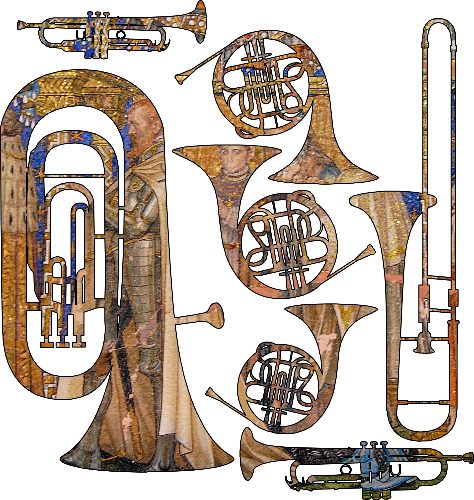Results
-

Procession of the Nobles | Rimsky-Korsakov arr. Alwyn Green (10)
An arrangement by Alwyn Green for 10 piece Brass ensemble, The Procession of the Nobles is the only familiar music from the Mlada Suite by Rimsky-Korsakov.The music bursts to life with a rousing flourish, soon followed by a noble processional tune. The music is full of colour and energy, with a beautiful melodic section, before the central vigorous section leads to a return to the march theme, and a rousing close.The Procession of the Nobles is played by Prince of Wales BrassInstrumentation1st Trumpet in Eb2nd Trumpet in Bb3rd Trumpet in BbFlugelhorn in BbHorn in F1st Trombone2nd TromboneBass TromboneEuphoniumTubaPercussion Parts (2):1. Timpani2. Glockenspiel/Side Drum/Cymbal TriangleISMN: 979-0-708127-13-0
-

The Day Thou Gavest | Ellerton arr. Alwyn Green
This beautiful traditional hymn is masterfully arranged by Alwyn Green.The mellow melody opens on single Euphonium, before being joined by Baritone and Tenor horn.The sound expands, yet quietly and prayerfully as the band joins. The music crescendo's into a grand finale with timpani and cymbal accompaniment.A great choice for a hymn piece.InstrumentationSoprano, Solo, Repiano, 2nd and 3rd CornetsFlugelhornSolo, 1st and 2nd Tenor Horns1st and 2nd Baritone1st, 2nd and Bass TromboneEuphoniumEb and Bb BassesPercussion parts (2):1: Timpani2: CymbalISMN: 979-0-708127-03-1
-

The Gartan Mother's Lullaby | trad. arr. William Hill
"The Gartan Mothers Lullaby"Dusk is drawn and the Green Man's thorn is wreathed in rings of fog,Siabra sails his boat till morn, upon the starry bog.A leanbhan O, the pale moon hath brimmed her cusp in dew,And weeps to hear the sad sleep-tune, I sing O love of you.A lovely Irish melody from Co. Donegal; the lullaby of a mother to her child. The song refers to a number of figures in Irish mythology, places in Ireland and words in the Irish language.The best known recording of the song was made by Meryl Streep in 2000. Instrumentation:Cornet SoloistSoprano, Solo/Repiano, 2nd and 3rd Cornets Flugelhorn Solo, 1st and 2nd Tenor Horns 1st and 2nd Baritone 1st, 2nd and Bass Trombone Euphonium Eb and Bb Basses
-

The Sorcerer's Apprentice | Dukas arr. Alwyn Green
Most of us are familiar with the symphonic poem written by 19th century composer, Paul Dukas, which was inspired by an 18th century poem by Goethe in which the sorcerer's apprentice, desiring to save himself some work attempts to try his hand at his masters craft when things go terribly wrong!This version, arranged by Alwyn Green for Brass Band, captures the spirit of the original masterpiece in a complex and challenging score for Brass Band. It has all the drama, and vibrant energy of the Dukas masterpiece, brilliantly orchestrated for Brass Band.Listen to the piece played by Foresters Brass 2000, from their CD : 'Heritage' which can be obtained from the band.Instrumentation: Soprano, Solo, Repiano, 2nd and 3rd CornetsFlugelhornSolo, 1st and 2nd Tenor Horns1st and 2nd Baritone1st, 2nd and Bass TromboneEuphoniumEb and Bb BassesPercussion parts (4):1: Timpani2: Cymbal3: Glockenspiel4: VibraphoneISMN: 979-0-708127-01-7
-
 £37.95
£37.95Jeannie with the Light Brown Hair (Euphonium Solo with Small Brass Band - Score and Parts) - Foster, Stephen C. - Howarth, Elgar
Euphonium Solo. Please note: There are no cornets in this arrangement. Recorded on Polyphonic QPRL064D Midnight EuphoniumParts included are: Conductor, Solo Euphonium, Flugel Horn, 1st Horn, 2nd Horn, 3rd Horn, 1st Baritone, 2nd Baritone, 1st and 2nd Trombone, Bass Trombone, Tutti Euphonium and Eb Tuba.
Estimated dispatch 7-14 working days
-
 £37.95
£37.95Benvenuto Cellini (Brass Band - Score only) - Berlioz, Hector - Wright, Frank
Berlioz's opera Benvenuto Cellini was first produced in Paris in 1838 but was withdrawn as a failure, and it was not until the production in Dresden in 1888 that it was finally acclaimed by the Germans as a triumph. Adapted from certain episodes recorded in the memoirs of Benvenuto Cellini, Tuscan sculptor and goldsmith, the story, laid in Rome during the mid-sixteenth century, is not strictly historical. The short opening Allegro, marked deciso con impeto, is conceived in the most brilliant Berlioz manner, utilising full instrumentation. In the Larghetto we meet at once the first of the opera themes - the Cardinal's aria (from the last act) introduced in the bass, quasi pizzicato. A second melody leads to a resumption of the Allegro, the contrasting second subject in the tenor horns being an adaptation of Teresa's aria (Act I). Towards the end the Cardinal theme is re-introduced by trombones, fortissimo against an energetic cornet and euphonium passage (senza stringendo - without hurry, says the score). After a unison passage storming skywards, there is a sudden, dramatic three-bar silent pause broken by Eb basses alone, again stating the Cardinal theme. A simple molto crescendo on the dominant, begun piano, leads to the long, resounding chord.
Estimated dispatch 7-14 working days
-
 £82.95
£82.95Benvenuto Cellini (Brass Band - Score and Parts) - Berlioz, Hector - Wright, Frank
Berlioz's opera Benvenuto Cellini was first produced in Paris in 1838 but was withdrawn as a failure, and it was not until the production in Dresden in 1888 that it was finally acclaimed by the Germans as a triumph. Adapted from certain episodes recorded in the memoirs of Benvenuto Cellini, Tuscan sculptor and goldsmith, the story, laid in Rome during the mid-sixteenth century, is not strictly historical. The short opening Allegro, marked deciso con impeto, is conceived in the most brilliant Berlioz manner, utilising full instrumentation. In the Larghetto we meet at once the first of the opera themes - the Cardinal's aria (from the last act) introduced in the bass, quasi pizzicato. A second melody leads to a resumption of the Allegro, the contrasting second subject in the tenor horns being an adaptation of Teresa's aria (Act I). Towards the end the Cardinal theme is re-introduced by trombones, fortissimo against an energetic cornet and euphonium passage (senza stringendo - without hurry, says the score). After a unison passage storming skywards, there is a sudden, dramatic three-bar silent pause broken by Eb basses alone, again stating the Cardinal theme. A simple molto crescendo on the dominant, begun piano, leads to the long, resounding chord.
Estimated dispatch 7-14 working days
-
 £19.95
£19.95Timepiece (Brass Quartet)
For brass quartet (2 Trumpets/Cornets, Horn Eb and Euphonium). Commissioned for the 1994 Swiss Quartet Championships. (Horn in F and Euphonium bass clef parts included).
Estimated dispatch 7-14 working days
